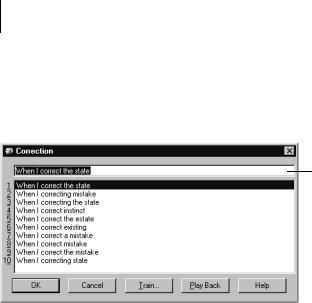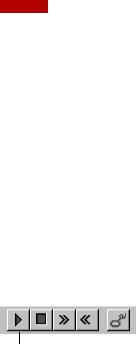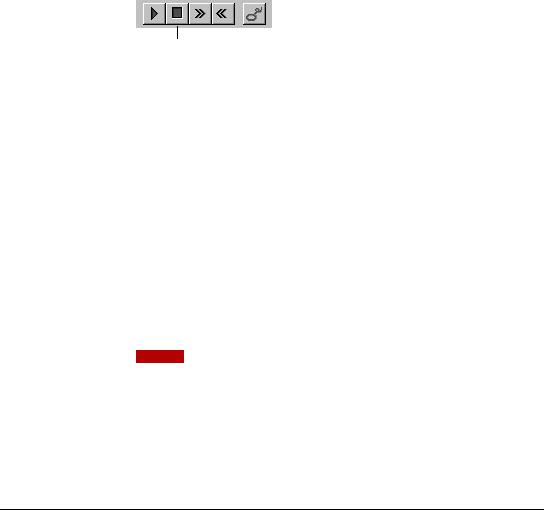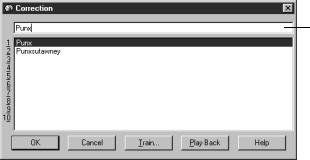Nuance DRAGON NATURALLY SPEAKING User Manual

Dragon
NaturallySpeakingTM
U S E R ’ S G U I D E
August 1999. Version 4.0.
This publication may not include some last-minute technical changes and/or revisions to the program. Changes are periodically made to the information described here. Future editions of this manual will incorporate these changes. For last-minute changes that are not incorporated in this edition, refer to the Readme file included in your program.
Dragon Systems® may have patents or pending patent applications covering subject matter in this document. The furnishing of this document does not give you any license to these patents. The software is subject to one or more of these U.S. patents: 4,783,803; 4,803,729; 4,805,218; 4,805,219; 4,829,576; 4,829,578; 4,837,831; 4,866,778; 4,903,305; 4,914,703; 5,027,406; 5,202,952; 5,428,707; 5,526,463; 5,680,511; 5,715,367; 5,754,972; 5,765,132; 5,794,189; 5,799,279; 5,809,453; 5,818,423; 5,822,730; 5,850,627; 5,903,864; 5,909,666; 5,915,236; 5,920,836; 5,920,837.
© Copyright 1999 Dragon Systems, Inc. All rights reserved.
No part of this manual or software may be reproduced in any form or by any means, electronic or mechanical, including photocopying, recording, or by any information storage and retrieval systems, without the express written consent of Dragon Systems, Inc.
Many of the designations used by manufacturers and sellers to distinguish their products are claimed as trademarks. Where those designations appear in this book, and where Dragon Systems is aware of the trademark, the first occurrence of the designation is printed with a trademark (™) or registered trademark (®) symbol.
Dragon Systems, the Dragon Systems logo, and NaturallySpeaking are registered trademarks and MouseGrid, NaturallyMobile, NaturalWeb, NaturalWord, Select-and-Say, Vocabulary Builder, and Vocabulary Editor are trademarks of Dragon Systems, Inc.
Adobe and Acrobat are registered trademarks of Adobe Systems Incorporated.
Corel and WordPerfect are registered trademarks of Corel Corporation.
The Dragon Systems, Inc., Text-to-Speech utility uses the Elan Text-to-Speech engine, which is licensed from Elan Informatique.
Lotus and Lotus Notes are registered trademarks of Lotus Development Corporation.
Microsoft, Windows, and Windows NT are registered trademarks and Outlook is a trademark of Microsoft Corporation.
Netscape and Netscape Navigator are registered trademarks of Netscape Communications Corporation in the United States and other countries.
Voice It and the Voice It logo are registered trademarks and Voice It Link is a trademark of Voice It Worldwide, Inc.
Yahoo! is a registered trademark of Yahoo! Inc.
Dave Barry in Cyberspace, © Copyright 1996 by Dave Barry. Published by Crown Publishers.
2001: A Space Odyssey, © Copyright 1968 by Arthur C. Clarke. Published by New American Library.
3001: The Final Odyssey, © Copyright 1997 by Arthur C. Clarke. Published by HarperCollins Publishers.
Dogbert’s Top Secret Management Handbook, © Copyright 1996 by United Feature Syndicate, Inc. Published by HarperBusiness, a division of HarperCollins Publishers.
Success Is a Journey: 7 Steps to Achieving Success in the Business of Life, © Copyright 1999 by Jeffrey J. Mayer. Published by McGraw Hill.
Charlie and the Chocolate Factory, © Copyright 1964 by Roald Dahl. Published by Alfred A. Knopf, Inc. and Penguin Books.
Charlie and the Great Glass Elevator, © Copyright 1972 by Roald Dahl. Published by Alfred A. Knopf, Inc. and Penguin Books.
To Be a Man, © Copyright 1997 by Eugene and Miranda Pool.
Ghost Brother, © Copyright 1990 by C.S. Adler. Published by Houghton Mifflin Company.
The Captain of Battery Park, © Copyright 1978 by Eugene Pool. Published by Addison-Wesley.
03-203-40-01
Contents
|
|
About This Guide 1 |
|
|
C H A P T E R |
1 |
Introducing Dragon NaturallySpeaking 3 |
|
|
|
|
What should I expect from Dragon NaturallySpeaking? 4 |
|
|
|
|
Do I still need my mouse and keyboard? 5 |
|
|
C H A P T E R |
2 |
Using Dragon NaturallySpeaking Successfully |
7 |
|
|
|
How Dragon NaturallySpeaking works |
7 |
|
|
|
Seven habits for success with Dragon NaturallySpeaking |
9 |
|
|
|
Positioning your microphone correctly |
9 |
|
|
|
Speaking properly to the computer 10 |
|
|
Speak naturally and continuously, but pronounce each word clearly |
11 |
||||||
Avoid leaving out words and making extra sounds (like “um”) |
11 |
|
|||||
Speak at your normal pace—don’t slow down |
11 |
|
|
||||
Speak in phrases, rather than one word at a time 12 |
|
|
|||||
Speak at your normal volume—don’t whisper or speak too loudly |
12 |
||||||
Correcting recognition mistakes 13 |
|
|
|
||||
Correcting mistakes |
13 |
|
|
|
|
|
|
Editing in the Correction dialog box |
17 |
|
|
|
|||
Playing back your dictation while you correct |
19 |
|
|
||||
Adding words to the Dragon NaturallySpeaking vocabulary |
21 |
|
|||||
About the vocabulary |
22 |
|
|
|
|
|
|
Adding words when correcting mistakes 24 |
|
|
|
||||
Adding words in Vocabulary Editor |
24 |
|
|
|
|||
Using Find New Words |
26 |
|
|
|
|
|
|
Running Vocabulary Builder |
29 |
|
|
|
|
||
Preparing documents |
30 |
|
|
|
|
|
|
Adding words from a list |
31 |
|
|
|
|
|
|
Running Vocabulary Builder |
32 |
|
|
|
|
||
Adding words found in documents |
35 |
|
|
|
|||
Dragon NaturallySpeaking User’s Guide |
iii |
|
|
Contents
|
Training Dragon NaturallySpeaking to recognize problem words |
38 |
|||||||
|
Training words after making corrections |
38 |
|
||||||
|
Training words when using Find New Words or Vocabulary Builder |
40 |
|||||||
|
Training words from Vocabulary Editor |
40 |
|
||||||
|
Training words from the Tools menu |
41 |
|
||||||
|
Training a voice command |
41 |
|
|
|
|
|||
|
Running General Training again |
43 |
|
|
|
||||
|
Creating specialized vocabularies |
44 |
|
|
|
||||
|
Creating vocabularies |
45 |
|
|
|
|
|
||
|
Opening vocabularies |
46 |
|
|
|
|
|
||
|
Renaming vocabularies |
46 |
|
|
|
|
|||
|
Deleting vocabularies |
46 |
|
|
|
|
|
||
|
Importing and exporting vocabularies |
|
47 |
|
|||||
C H A P T E R 3 |
More About Dictating |
49 |
|
|
|
|
|||
|
Preventing vocal strain |
49 |
|
|
|
|
|
||
|
Dictating names of people, places, and events 50 |
|
|||||||
|
Dictating abbreviations and acronyms |
|
51 |
|
|||||
|
Dictating hyphenated words |
52 |
|
|
|
|
|||
|
Including hyphens as you dictate |
52 |
|
|
|
||||
|
Adding hyphens later |
52 |
|
|
|
|
|
||
|
Removing hyphens |
53 |
|
|
|
|
|
||
|
Preventing hyphens |
53 |
|
|
|
|
|
||
|
Dictating compound words |
53 |
|
|
|
|
|||
|
Compounding words as you dictate 54 |
|
|
||||||
|
Compounding words later |
54 |
|
|
|
|
|||
|
Dictating words that end with ’s |
55 |
|
|
|
||||
|
Including ’s as you dictate |
55 |
|
|
|
|
|||
|
Adding ’s later |
55 |
|
|
|
|
|
|
|
|
Dictating e-mail and Web addresses |
56 |
|
||||||
|
Dictating special characters |
57 |
|
|
|
|
|||
|
Dictating common special characters |
57 |
|
||||||
|
Dictating uncommon special characters |
|
57 |
|
|||||
|
Dictating foreign words |
60 |
|
|
|
|
|
||
|
Dictating numbers |
61 |
|
|
|
|
|
|
|
|
Numerals and Zip codes 61 |
|
|
|
|
||||
|
Dates 63 |
|
|
|
|
|
|
|
|
|
Times of day |
63 |
|
|
|
|
|
|
|
|
Telephone numbers |
64 |
|
|
|
|
|
||
|
Currency and coin |
64 |
|
|
|
|
|
|
|
|
Fractions 65 |
|
|
|
|
|
|
|
|
|
Roman numerals |
65 |
|
|
|
|
|
|
|
Creating dictation shorthands 66
iv |
Dragon NaturallySpeaking User’s Guide |
|
|
Contents
C H A P T E R 4 |
Editing a Document by Voice |
|
69 |
|
|
|||||
|
Moving around in a document |
70 |
|
|
|
|
||||
|
Going to the top or bottom of a page |
|
70 |
|
|
|||||
|
Going to the beginning or end of a line |
70 |
|
|
||||||
|
Placing the cursor before or after a specific word |
70 |
||||||||
|
Moving up or down a paragraph |
71 |
|
|
||||||
|
Moving up or down a line |
72 |
|
|
|
|
|
|||
|
Moving right or left a word |
72 |
|
|
|
|
||||
|
Moving right or left a character |
73 |
|
|
|
|||||
|
Selecting text |
73 |
|
|
|
|
|
|
|
|
|
Select-and-Say 73 |
|
|
|
|
|
|
|
|
|
|
Selecting the same text again |
74 |
|
|
|
|
||||
|
Unselecting words |
74 |
|
|
|
|
|
|
|
|
|
Selecting a range of words |
75 |
|
|
|
|
|
|||
|
Selecting your whole document |
75 |
|
|
|
|
||||
|
Selecting an entire paragraph or line |
76 |
|
|
||||||
|
Selecting a word or character |
76 |
|
|
|
|
||||
|
Copying, cutting, and pasting text |
77 |
|
|
||||||
|
Capitalizing text 77 |
|
|
|
|
|
|
|
|
|
|
Capitalizing the first letter of the next word you dictate 77 |
|||||||||
|
Capitalizing consecutive words |
78 |
|
|
|
|||||
|
Dictating the next word in all capital letters 78 |
|
||||||||
|
Dictating consecutive words in all capital letters |
79 |
||||||||
|
Dictating the next word in all lowercase letters |
79 |
|
|||||||
|
Dictating consecutive words in all lowercase letters |
79 |
||||||||
|
Capitalizing (or uncapitalizing) text already in your document 80 |
|||||||||
|
Formatting text |
80 |
|
|
|
|
|
|
|
|
|
Adding (or removing) bold, italics, and underlining |
80 |
||||||||
|
Changing the font as you dictate |
80 |
|
|
|
|||||
|
Changing the font later |
82 |
|
|
|
|
|
|
||
|
Aligning text |
82 |
|
|
|
|
|
|
|
|
|
Deleting text |
83 |
|
|
|
|
|
|
|
|
|
Deleting the last words you dictated |
|
83 |
|
|
|||||
|
Backing up as you dictate |
83 |
|
|
|
|
|
|||
|
Deleting specific words |
84 |
|
|
|
|
|
|
||
|
Deleting the next or previous paragraph 84 |
|
|
|||||||
|
Deleting the next or previous word or character |
84 |
|
|||||||
|
Using text-to-speech |
85 |
|
|
|
|
|
|
|
|
Dragon NaturallySpeaking User’s Guide |
v |
|
|
Contents
C H A P T E R 5 |
Controlling Your Computer by Voice |
87 |
|
|||||||
|
Starting programs |
88 |
|
|
|
|
|
|
|
|
|
Starting a program from the Start menu |
88 |
|
|
||||||
|
Starting a program from the Windows desktop |
89 |
|
|||||||
|
Opening documents and folders |
89 |
|
|
|
|||||
|
Opening documents and folders from the Start menu |
89 |
||||||||
|
Opening documents and folders from the Windows desktop 90 |
|||||||||
|
Switching between open windows |
90 |
|
|
|
|||||
|
Copying text to other programs |
91 |
|
|
|
|
||||
|
Opening and closing menus |
91 |
|
|
|
|
||||
|
Selecting buttons, tabs, and options |
93 |
|
|
|
|||||
|
Selecting icons on the desktop |
93 |
|
|
|
|
||||
|
Resizing and closing windows |
94 |
|
|
|
|
||||
|
Scrolling in windows and list boxes |
95 |
|
|
|
|||||
|
Controlling Internet Explorer |
96 |
|
|
|
|
||||
|
Going to favorite Web pages |
97 |
|
|
|
|
||||
|
Entering a Web address in the Address bar |
98 |
|
|
||||||
|
Going back or forward to the previous Web page |
98 |
|
|||||||
|
Following links (words, buttons, and images) |
99 |
|
|||||||
|
Scrolling in a Web page |
100 |
|
|
|
|
|
|||
|
Selecting check boxes and other options 101 |
|
|
|||||||
|
Entering text in a text box |
102 |
|
|
|
|
||||
|
Troubleshooting |
103 |
|
|
|
|
|
|
|
|
|
Pressing keyboard keys |
103 |
|
|
|
|
|
|||
|
Pressing letters |
104 |
|
|
|
|
|
|
|
|
|
Capitalizing a letter |
105 |
|
|
|
|
|
|
||
|
Pressing numbers |
105 |
|
|
|
|
|
|
|
|
|
Pressing key combinations |
105 |
|
|
|
|
||||
|
Pressing function and numeric keypad keys |
106 |
|
|||||||
|
Pressing other keys |
106 |
|
|
|
|
|
|
|
|
|
Moving the mouse pointer and clicking the mouse |
107 |
||||||||
|
Moving the mouse pointer with MouseGrid |
107 |
|
|||||||
|
Moving the pointer with the “Mouse” command |
109 |
|
|||||||
|
Clicking the mouse |
109 |
|
|
|
|
|
|
|
|
|
Marking and dragging objects |
110 |
|
|
|
|
||||
vi |
Dragon NaturallySpeaking User’s Guide |
|
|
Contents
C H A P T E R 6 |
Creating New Users and Managing Users |
111 |
||
|
Creating a new user |
112 |
|
|
|
Opening a user |
112 |
|
|
|
Renaming a user |
113 |
|
|
|
Backing up a user |
113 |
|
|
|
Restoring a backup copy of a user 114 |
|
||
|
Deleting a user |
115 |
|
|
A P P E N D I X A |
Using Dragon NaturallyMobile 117 |
|
||
A P P E N D I X B |
Dragon NaturallySpeaking Commands List |
129 |
||
I N D E X |
159 |
|
|
|
Dragon NaturallySpeaking User’s Guide |
vii |
|
|

About This Guide
elcome to Dragon NaturallySpeaking , the world’s most widely Wacclaimed speech-recognition product®. Dragon NaturallySpeaking lets you talk to your computer instead of typing. It also lets you use your voice to control your computer in other ways.
This guide provides detailed information that will help you get the most out of using the program. It also explains how to ensure that Dragon NaturallySpeaking will recognize your speech accurately. Before using this guide, we recommend that you read the Dragon NaturallySpeaking Quick Start booklet and view the online Quick Tour.
This guide covers multiple editions of Dragon NaturallySpeaking. Where information applies to certain editions only, this is clearly noted.
Conventions used in this guide
This user’s guide contains many examples of words and phrases you can say when using Dragon NaturallySpeaking. These examples usually appear in italics with quotation marks, for instance: “Scratch That.”
Some procedures also include sample text for you to dictate. Sample text appears in a different typeface, with punctuation in square brackets. For example:
When talking to a computer [comma] try to say every word clearly without trailing off at the end of a sentence [period]
Dragon NaturallySpeaking User’s Guide |
1 |
|
|
About This Guide
Comments?
If you have comments about this user’s guide or any part of the Dragon NaturallySpeaking documentation, we hope you’ll let us know what you think.
You can e-mail comments to: doccomments@dragonsys.com.
Thank you!
2 |
Dragon NaturallySpeaking User’s Guide |
|
|

C H A P T E R 1
Introducing Dragon
NaturallySpeaking
Dragon NaturallySpeaking lets you talk to your computer instead of typing. As you talk, your words are transcribed onto your screen and
into your documents or e-mail messages.
Talking to a computer while it types what you say is called dictating. You can dictate into Microsoft® Word, Corel® WordPerfect®, e-mail programs, personal information organizers, and virtually any other program in which you normally type.
Dragon NaturallySpeaking is good for:
■Composing letters, memos, and e-mail messages. Just think about what you want to say, and then say it into the microphone.
■Writing a report, article, or story. Brainstorm out loud and capture your thoughts on screen. Then edit your work by voice or mouse and keyboard.
■“Typing up” notes from a meeting. When you get back to your desk, simply read your notes into the microphone.
You can also use simple voice commands to revise and format text, move around your document, and control your computer. Learn the basics in your Dragon NaturallySpeaking Quick Start booklet.
Dragon NaturallySpeaking isn’t just for typing, however. You can also use your voice to start programs, open menus, and click buttons. If you use Internet Explorer to browse the Web, you can use Dragon NaturallySpeaking to follow links and go to favorite sites by voice. You can learn how in Chapter 5, “Controlling Your Computer by Voice.”
Dragon NaturallySpeaking User’s Guide |
3 |
|
|

C H A P T E R 1 |
Introducing Dragon NaturallySpeaking |
|
|
If you share your computer with family members, friends, or colleagues, they can also use Dragon NaturallySpeaking. Simply create a new set of “user speech files” for each person who wants to talk to the computer.
Find out how in Chapter 6, “Creating New Users and Managing Users.”
After you become comfortable talking to your computer, you may want to take the convenience of dictating a step further by using a portable recorder with Dragon NaturallySpeaking. This option is available if you have Dragon NaturallySpeaking Preferred or Professional. We recommend that you buy the Dragon NaturallyMobile™ recorder (a handheld digital recorder offered by Dragon Systems) but you can also use a recorder you already own. For more information, see Appendix A, “Using Dragon NaturallyMobile.”
If you have Dragon NaturallySpeaking Professional, you can expand the power of using speech by creating your own voice commands. Find out how in Chapter 7, “Creating Your Own Dragon NaturallySpeaking Commands” (Professional edition only).
The Professional edition also lets you create and customize additional vocabularies for dictating in different subject areas. For more information, see “Creating specialized vocabularies” on page 44.
What should I expect from
Dragon NaturallySpeaking?
One reason to use Dragon NaturallySpeaking is to do your writing more quickly. Another is to reduce the stress associated with keyboarding. Or maybe you just like the idea of being able to lean back in your chair, put your feet up on the desk, and still get work done.
Dragon NaturallySpeaking is good for all these reasons, but making it work well requires some effort from you. Dragon NaturallySpeaking actually learns about your voice and pronunciation as you use it. When you use words the program doesn’t know, it will make mistakes, and you’ll have to stop and correct them.
It may take a while before you feel comfortable and productive using
Dragon NaturallySpeaking. You can find out more about how to make
4 |
Dragon NaturallySpeaking User’s Guide |
|
|

C H A P T E R 1 |
Introducing Dragon NaturallySpeaking |
|
|
the program work well by reading Chapter 2, “Using Dragon NaturallySpeaking Successfully.”
Do I still need my mouse and keyboard?
Although you can use Dragon NaturallySpeaking to do almost everything on your computer by voice, some things are still easier to do by mouse or keyboard.
If using a mouse and keyboard is an option for you, try experimenting with using your voice and using your hands for different tasks, to see what works best. If using a mouse and keyboard is not an option, read Chapter 5, “Controlling Your Computer by Voice.”
Dragon NaturallySpeaking User’s Guide |
5 |
|
|

C H A P T E R 2
Using Dragon
NaturallySpeaking
Successfully
If you followed the exercises in your Dragon NaturallySpeaking Quick Start booklet, by now you’ve had a chance to try dictating with
Dragon NaturallySpeaking. So, are you ready to throw away your keyboard? Probably not. Chances are there are more mistakes in your document than you’d like to see.
Why does the program make mistakes, and what can be done so it makes them less often? This chapter provides some background information to help you understand how Dragon NaturallySpeaking works. It then reveals the “Seven habits for success with Dragon NaturallySpeaking,” a list of tips and procedures you can follow to make the program recognize your speech accurately.
How Dragon NaturallySpeaking works
When you talk into the microphone, Dragon NaturallySpeaking doesn’t hear words or phrases. The computer hears your speech as a continuous stream of sounds. From this stream, Dragon NaturallySpeaking picks out common sound patterns, known as phonemes.
To match these sound patterns to words, Dragon NaturallySpeaking relies on two large sources of data: acoustical data and language data.
Dragon NaturallySpeaking User’s Guide |
7 |
|
|
C H A P T E R 2 |
Using Dragon NaturallySpeaking Successfully |
|
|
Dragon NaturallySpeaking uses acoustical data about the sound patterns that make up different words to choose the words that most closely match what it heard. Since no two people sound exactly alike, Dragon NaturallySpeaking does a much better job of matching sounds to words when it knows something about your pronunciation. When you first trained the program, you provided acoustical data on top of what Dragon NaturallySpeaking already knows about the sounds of English.
Sometimes it’s not possible for Dragon NaturallySpeaking to choose the correct word based on sound alone. Consider these two phrases: “pizza delivery boy” and “Pete’s a delivery boy.” When spoken, they sound exactly alike. How would Dragon NaturallySpeaking know which to choose? When it’s not clear from sound alone what was said, Dragon NaturallySpeaking uses language data about the frequency with which words in English appear alone and in combination with others to determine which words were most likely spoken. The phrase “pizza delivery boy” is more common than “Pete’s a delivery boy,” so the program would favor this phrase over the other.
Since people write differently, it helps if Dragon NaturallySpeaking knows something about the frequency with which you use different words. When you run Vocabulary Builder™, or make corrections in the Correction dialog box, you’re providing the program with language data about how often you use different words.
Knowing that Dragon NaturallySpeaking uses acoustical data and language data to recognize your speech can help you know what to do to make the program work better.
8 |
Dragon NaturallySpeaking User’s Guide |
|
|

C H A P T E R 2 |
Using Dragon NaturallySpeaking Successfully |
|
|
Seven habits for success with
Dragon NaturallySpeaking
The rest of this chapter describes seven habits you can adopt to make Dragon NaturallySpeaking work well for you. If you make the techniques and procedures in this chapter a habit, and continue to use Dragon NaturallySpeaking regularly, you should be able to make the program recognize your speech accurately 95–98 percent of the time.
Seven habits for success with Dragon
NaturallySpeaking
■Position your microphone correctly
■Speak properly to the computer
■Correct recognition mistakes
■Add words to the Dragon NaturallySpeaking vocabulary
■Run Vocabulary Builder
■Train Dragon NaturallySpeaking to recognize problem words
■Run General Training again
If you have Dragon NaturallySpeaking Professional, you can also create specialized vocabularies to enhance recognition accuracy. See “Creating specialized vocabularies” on page 44.
Positioning your microphone correctly
You’ve already heard a lot about the importance of your microphone position. If you followed the instructions on the screen when you first started Dragon NaturallySpeaking, your microphone is probably in about the right position. But you should continue to think about your microphone and check its position frequently to make sure it hasn’t moved out of place.
Dragon NaturallySpeaking User’s Guide |
9 |
|
|

C H A P T E R 2 |
Using Dragon NaturallySpeaking Successfully |
|
|
If you find that Dragon NaturallySpeaking is making too many mistakes, experiment with moving the microphone a little closer to or farther from your mouth.
If extra words, such as “and” and “the,” are often inserted into your document, Dragon NaturallySpeaking may be interpreting the sound of your breath as speech. Try moving the microphone slightly to the side, so it’s not directly in front of your mouth.
Keep in mind that it’s easy for the microphone to move slightly out of the best position. You might not notice if this happens, because Dragon NaturallySpeaking may still get most of your words right. But if the microphone is even slightly out of place, the program may no longer be able to tell the difference between similar-sounding words, such as “our” and “are,” and will begin making subtle mistakes.
Make it a habit to check your microphone position regularly. If accuracy ever seems lower than normal, always start by checking your microphone.
TIP You can double-check your microphone position at any time by running the Audio
Setup Wizard. (On the Dragon NaturallySpeaking Tools menu, click Audio Setup
Wizard.) Make sure your audio quality is reported to be “Acceptable.”
Speaking properly to the computer
At times the computer will type something that sounds like what you said but isn’t quite right. People sometimes misunderstand each other in the same way. But the computer is not a person, so it won’t help to:
YELL
t a l k s l o w l y
or. say. only. one. word. at. a. time.
This section provides some guidelines for talking to a computer.
10 |
Dragon NaturallySpeaking User’s Guide |
|
|
C H A P T E R 2 |
Using Dragon NaturallySpeaking Successfully |
|
|
Speak naturally and continuously, but pronounce each word clearly
When you talk to another person, you can mumble and run your words together and still be understood most of the time. For example, if you say, “Didja eat?,” a person will probably understand that you’re asking, “Did you eat?”
But Dragon NaturallySpeaking has trouble interpreting mumbled or slurred speech. The computer recognizes speech most accurately when it can hear each word distinctly.
To understand what it means to speak both clearly and naturally, listen to the way newscasters read the news. If you copy this style when you use Dragon NaturallySpeaking, you should see an improvement in how well the program recognizes what you say.
Make it a habit to say each word clearly when you talk to the computer.
Avoid leaving out words and making extra sounds (like “um”)
In conversation with another person, it’s okay if you leave out a word here and there. People are good at filling in the blanks in a sentence. Unfortunately, the computer is not very good at this. If you leave out words, Dragon NaturallySpeaking also leaves them out.
Another thing people do well is ignore all those “ums” and “you knows” that show up in conversation. But the computer has no way of knowing which words are unimportant, so it simply transcribes everything you say.
Make it a habit to avoid leaving out words or making extra sounds. It may help to compose your thoughts before you speak.
Speak at your normal pace—don’t slow down
When another person is having trouble understanding you, speaking more slowly usually helps. So it’s not surprising that people often slow down and begin sounding out each syllable when Dragon NaturallySpeaking makes mistakes.
It doesn’t help to speak at an unnatural pace when you’re talking to a computer, however. This is because the program listens for predictable
Dragon NaturallySpeaking User’s Guide |
11 |
|
|
C H A P T E R 2 |
Using Dragon NaturallySpeaking Successfully |
|
|
sound patterns when matching sounds to words. If you speak in syllables, Dragon NaturallySpeaking is likely to transcribe each syllable as a separate word.
Make it a habit to speak at your normal pace, so Dragon
NaturallySpeaking can learn your normal pronunciation.
Speak in phrases, rather than one word at a time
Along with the tendency to speak slowly, people often begin saying just one or two words at a time when Dragon NaturallySpeaking makes mistakes.
Surprisingly, speaking in very short phrases or individual words can actually lessen accuracy. This is because Dragon NaturallySpeaking uses the context of a phrase to help it decide what you said.
Consider the following phrase: “Dear Mr. Jones.” If you were to dictate this phrase one word at a time (“dear” “mister” “jones”), Dragon NaturallySpeaking might type “Deer” or “Gear,” instead of “Dear.” But if you were to dictate the whole phrase (“dear mister jones”), the program can use context to determine that the word you want is most likely “Dear.”
Make it a habit to dictate in phrases, so Dragon NaturallySpeaking can use context to help determine what you said. It may help to compose your thoughts before you speak.
Speak at your normal volume—don’t whisper or speak too loudly
When you first started Dragon NaturallySpeaking and read the training text aloud, the program adapted to the pitch and volume of your voice, along with learning your pronunciation.
For this reason, you should continue to speak at a normal volume (or slightly louder if this helps). If you shout or whisper, Dragon NaturallySpeaking won’t understand you as well.
Make it a habit to speak at your normal volume, since Dragon
NaturallySpeaking has adjusted to this volume.
12 |
Dragon NaturallySpeaking User’s Guide |
|
|

C H A P T E R 2 |
Using Dragon NaturallySpeaking Successfully |
|
|
Correcting recognition mistakes
When Dragon NaturallySpeaking types the wrong words, you should correct these mistakes by using the Correction dialog box. By correcting mistakes, you actually teach the program not to make the same mistakes again.
Correcting mistakes in the Correction dialog box requires some extra effort, but it saves you time in the long run by making Dragon NaturallySpeaking more accurate.
You’ll probably need to use the Correction dialog box often when you first start using Dragon NaturallySpeaking, and then less and less as the program learns from your corrections.
Correcting mistakes
You can correct mistakes as soon as they happen or go back and correct them later. This section describes each approach.
Correcting mistakes as soon as they happen
When you see a mistake in your last word or phrase, you can stop and correct it by saying “Correct That.”
To correct your last word or phrase:
As soon as you see a mistake, say “Correct That.” Saying “Correct That” opens the Correction dialog box.
TIP You can use a keyboard shortcut to open the Correction dialog box. It’s the minus (-) key on the numeric keypad.
About “Correct That”
Using “Correct That” to correct your last phrase is practical only when the phrase is fairly short (fewer than 20 words). A longer phrase may not fit completely in the Correction dialog box, and it’s more difficult to find a correct alternative in the list for a long phrase.
To fix mistakes in a long phrase, you can correct just the specific wrong words. See “Going back and correcting mistakes later” on page 16.
Dragon NaturallySpeaking User’s Guide |
13 |
|
|

C H A P T E R 2
You can resize the Correction dialog box by dragging a corner or side.
Note: The Playback button is only in the Preferred and Professional editions.
Using Dragon NaturallySpeaking Successfully
Using the Correction dialog box
When the Correction dialog box opens, if the correct word or phrase is in the list of choices, you can simply choose it.
Text box
To choose the correct text:
There are two ways to choose the correct text:
■Say “Choose” and then the number of the correct alternative. For example, say “Choose 2” (or “Choose Numeral 2”).
■Click the correct alternative, and then click OK (or say “Click OK”).
This closes the Correction dialog box and enters the text into your document.
If none of the choices exactly matches what you said, you must enter the correct text.
To enter the correct text:
There are two ways to enter the correct text:
■Start typing the correct word or phrase into the text box. As you type, the list shows alternatives that match what you’ve typed so far.
■Start spelling the correct word or phrase. Say the letters continuously and quickly, not one at a time.
When you see the correct choice, choose it (by mouse or voice).
14 |
Dragon NaturallySpeaking User’s Guide |
|
|

C H A P T E R 2 |
Using Dragon NaturallySpeaking Successfully |
|
|
If the correct choice doesn’t appear, finish typing or spelling it and then click OK (or say “Click OK”).
Spelling in the Correction dialog box
To enter text in the Correction dialog box, you can either type it or spell it by voice. You can’t dictate whole words into the Correction dialog box.
When you’re spelling, this is what you can say:
■letters (a–z)
■International Communications Alphabet (alpha, bravo, and so on)
■numbers (0–9)
■punctuation
■“Cap” (to capitalize the next letter)
■“Double” (to enter the next letter twice, for example,
“Double a”)
■“Space Bar” or “space” (to insert a space)
■“Backspace”
■“apostrophe ess”
■special characters (such as @, *, £, ©, and é)
For a complete list of special characters, and the International Communications Alphabet, see “Correction dialog box commands” on page 142 of Appendix B.
TIP When one of the choices in the Correction dialog box is almost correct, you can select it and use it as a starting point without entering the text into your document. Just click it or say “Select” (not “Choose”) and then the number of the choice. For example, say “Select 3” (or “Select Numeral 3”). Then edit the word or phrase.
Dragon NaturallySpeaking User’s Guide |
15 |
|
|

C H A P T E R 2 |
Using Dragon NaturallySpeaking Successfully |
|
|
Going back and correcting mistakes later
If you’re going back to fix the mistakes in your document, you can correct a word or phrase by saying “Correct”* and then the word or phrase.
Or, you can correct a longer phrase by saying “Correct [text] Through [text].”* For [text], substitute the actual word or words at the beginning and the end of the range of wrong words.
This section describes each approach.
To correct a word or phrase:
1Correct a word or short phrase in your document by saying “Correct” followed by the wrong word or words (they must be visible on the screen). Remember not to pause in the middle of the command.
For example, you could correct the underlined words in the following sentence by saying “Correct who will develop a habit.”
With a little practice, who will develop a habit of dictating in a clear, steady voice, and the computer will understand you better.
2In the Correction dialog box, type or spell the correct words (in this example, “you will develop the habit”).
3Click OK (or say “Click OK”).
The Correction dialog box closes and the text is entered into your document. The cursor returns to where it was before you made the correction.
NOTE If you’re correcting more than one word, the words must all be in sequence (next to each other). You can’t use a single command to correct words that are in different parts of your document.
To correct a longer phrase:
1Correct a longer phrase in your document by saying “Correct [text] Through [text].” For [text], substitute the actual word or words at the
*This command works in the Dragon NaturallySpeaking window, but it doesn’t work in all programs. See “Which commands work in which programs?” on page 129 of Appendix B.
16 |
Dragon NaturallySpeaking User’s Guide |
|
|

C H A P T E R 2 |
Using Dragon NaturallySpeaking Successfully |
|
|
beginning and the end of the range of wrong words (they must be visible on the screen).
For example, you could correct the underlined words in the following sentence by saying “Correct who Through unclear” (or “Correct who will Through an unclear”).
With a little practice, who will develop a habit of dictating an unclear, steady voice, and the computer will understand you better.
2In the Correction dialog box, type or spell the correct words (in this example, “you will develop the habit of dictating in a clear”).
3When you’re finished, click OK (or say “Click OK”).
NOTE Some people prefer to correct the mistakes in their documents by using the mouse and keyboard. You can use your mouse to select the wrong words (or simply place your cursor somewhere in the mistake), and then press the minus (-) key on the numeric keypad to open the Correction dialog box.
Make it a habit to correct mistakes with the Correction dialog box to continue to improve the accuracy of the program. Be sure to save your speech files, when prompted, to preserve the adjustments the program makes.
Editing in the Correction dialog box
When you’re working in the Correction dialog box, you can use your voice to move the cursor and to select and delete words and characters.
Moving around in the Correction dialog box
You can move the cursor right or left by words, characters, or a combination of the two. For example, you can say “Move Right a Word,” “Move Left 4 Characters,” or “Move Left 1 Word and 2 Characters.”
Dragon NaturallySpeaking User’s Guide |
17 |
|
|

C H A P T E R 2 |
Using Dragon NaturallySpeaking Successfully |
|
|
See the complete list below:
SAY |
THEN (o ne ) |
THEN (o ne) |
Move |
Right |
a Word (or “1 Word”) |
|
Forward |
2 Words |
|
Left |
n Words (up to 20) |
|
Back |
a Character (or “1 Character”) |
|
|
2 Characters |
|
|
n Characters (up to 20) |
|
|
n Words and n Characters |
|
|
|
Selecting text in the Correction dialog box
You can select all the text in the text box by saying “Select Line.”
You can also select right or left by words, characters, or a combination of the two. For example, you can say “Select Next Character,” “Select Previous 2 Words,” or “Select Next Word and 1 Character.” See the complete list below:
SAY |
THEN (o ne ) |
THEN ( one) |
Select |
Next |
Word |
|
Forward |
2 Words |
|
Previous |
n Words (up to 20) |
|
Back |
Character |
|
|
4 Characters |
|
|
n Characters (up to 20) |
|
|
n Words and n Characters |
|
|
|
Deleting text in the Correction dialog box
You can delete selected text in the Correction dialog box by saying
“Delete Selection.”
You can also delete words, characters, or a combination of the two. For example, you can say “Delete Next Word,” “Delete Previous Character,” or “Delete Next Word and 1 Character.”
18 |
Dragon NaturallySpeaking User’s Guide |
|
|

C H A P T E R 2 |
Using Dragon NaturallySpeaking Successfully |
|
|
See the complete list below:
SAY |
THEN (o ne) |
THEN (one) |
Delete |
Next |
Word |
|
Forward |
2 Words |
|
Previous |
n Words (up to 20) |
|
Back |
Character |
|
|
4 Characters |
|
|
n Characters (up to 20) |
|
|
n Words and n Characters |
|
|
|
Playing back your dictation while you correct
Dictation playback is available in the Dragon NaturallySpeaking
Preferred and Professional editions.
Playback commands work in the Dragon NaturallySpeaking window,
Microsoft Word 97 and 2000, and Corel WordPerfect 8 and 9.
Although Dragon NaturallySpeaking never makes a spelling error, the mistakes it does make can be challenging to find and fix. Sometimes, what the program types looks very different from what you actually said.
To make correcting mistakes easier, Dragon NaturallySpeaking records your voice as you dictate. You can play back your voice whenever you can’t tell by looking at your document what you originally said.
NOTE Playback is available only until you close a document. After you close a
document, Dragon NaturallySpeaking deletes the recorded dictation for that document.
Playing back dictation in the Correction dialog box
When you’re working in the Correction dialog box, click the Play Back button to play the dictation that goes with the words you’re correcting. Then edit the text to match what you said.
You can set up Dragon NaturallySpeaking to play back dictation automatically whenever you open the Correction dialog box. (On the Tools menu, click Options, and then click the Miscellaneous tab. Select “Automatic playback on correction.”)
Dragon NaturallySpeaking User’s Guide |
19 |
|
|

C H A P T E R 2 |
Using Dragon NaturallySpeaking Successfully |
|
|
NOTE Sometimes, there’s no dictation to play back. For example, you can’t play back text that wasn’t entered by voice, such as words you typed or pasted into your document. You also can’t play back dictation after closing a document. If dictation is not available, the Play Back button is dimmed (grayed out). When playback is not available, you may find text-to-speech useful for checking your work. See “Using text-to-speech” on page 85.
Playing back dictation in a document
To help you check your work for mistakes, you can play back a line, a paragraph, a selection, or the whole document. After playback starts, you can stop it as soon as you notice a mistake and automatically open the Correction dialog box.
To play back dictation:
To play back dictation, do any of the following:
■Select the text you want to play back and say “Play That Back.”
■Click the Start Playback button on the Dragon NaturallySpeaking toolbar.
Start Playback
■Move the cursor to the text you want to play back and say any of the following commands:
SAY |
TO |
Play Back Line |
Play back dictation for the current line. |
|
|
Play Back Paragraph |
Play back dictation for the current paragraph. |
Play Back Document |
Play back dictation for the whole document. |
|
|
Play Back Window |
Play back dictation for the text in view. |
Play Back to Here |
Play back dictation from the top of the document |
|
window to the cursor. |
|
|
Play Back from Here |
Play back dictation from the cursor to the bottom |
|
of the document window. |
|
|
20 |
Dragon NaturallySpeaking User’s Guide |
|
|

C H A P T E R 2 |
Using Dragon NaturallySpeaking Successfully |
|
|
To stop playback:
To stop playback, do any of the following:
■Click the Stop Playback button on the Dragon NaturallySpeaking toolbar.
Stop Playback
■Click anywhere in the document window.
■Press the ESC key
(It’s not possible to stop playback by voice, because the computer can’t hear speech input when it’s playing back dictation.)
To stop playback and correct a mistake:
To stop playback and correct a mistake, do any of the following:
■Click the Correct button on the Dragon NaturallySpeaking toolbar.
 Correct
Correct
■Press the minus (-) key on the numeric keypad.
This stops playback and simultaneously opens the Correction dialog box. There you can correct the text for the last phrase played back.
NOTE By default, Dragon NaturallySpeaking stores about 45 minutes of dictation (60 MB). If you want to be able to store more dictation, you can change the amount of disk space that’s set aside for storing it. (On the Tools menu, click Options, and then click the Miscellaneous tab. Increase the number in the “Disk space reserved for speech data” box.)
Adding words to the Dragon
NaturallySpeaking vocabulary
If Dragon NaturallySpeaking gets a word wrong, it could be that the word is not in the program’s vocabulary. When this is the case, you need to teach Dragon NaturallySpeaking the new word so that it can recognize it when you say it.
Dragon NaturallySpeaking User’s Guide |
21 |
|
|
C H A P T E R 2 |
Using Dragon NaturallySpeaking Successfully |
|
|
About the vocabulary
The Dragon NaturallySpeaking vocabulary contains the words the program is capable of recognizing when you say them. The vocabulary contains thousands of words, their common pronunciations, and language data about how frequently words are used alone and in combination with others.
When you first start Dragon NaturallySpeaking, it creates a standard vocabulary on your computer. A vocabulary contains active words (the active vocabulary) and backup words (the backup dictionary).
Active words
The most commonly used vocabulary words are kept active (stored in computer memory). When you dictate these words, Dragon NaturallySpeaking is likely to get them right on the first try (that is, without requiring you to do anything extra such as correcting the words).
For example, all the words in the following sentence are active (including “Pennsauken”), so Dragon NaturallySpeaking should be able to recognize them all correctly on the first try.
Meet me in Pennsauken [comma] New Jersey
Don’t worry that the words you want to say won’t be active. The list of active words is very long and continually changes (as you correct mistakes) to always include words you’re likely to use.
Backup dictionary words
All the vocabulary words that are not currently active are kept in the backup dictionary (stored on disk, not in memory). Dragon NaturallySpeaking can recognize backup dictionary words, but not on the first try.
If Dragon NaturallySpeaking has trouble recognizing a word, it may mean that it’s a backup dictionary word. You can make a word active by correcting it in the Correction dialog box.
22 |
Dragon NaturallySpeaking User’s Guide |
|
|

C H A P T E R 2 |
Using Dragon NaturallySpeaking Successfully |
|
|
To correct a word and make it active:
1Dictate the following sentence. The word “Punxsutawney” (pronounced punks-ah-tawny) is in the backup dictionary, not the active vocabulary, so Dragon NaturallySpeaking won’t recognize it correctly on the first try.
Meet me in Punxsutawney [comma] Pennsylvania
When the program makes a mistake (for example, types “punks and Connie” instead of “Punxsutawney”), select the mistake and say
“Correct That.”
2Type or spell the correction in the Correction dialog box.
Since “Punxsutawney” is in the backup dictionary, it should appear in the list of alternatives before you finish entering it. (The list of alternatives always displays possible endings for the text in the text box.)
Text box
3Click OK (or say “Click OK”).
The Correction dialog box closes and “Punxsutawney” becomes an active word.
The next time you dictate “Punxsutawney,” Dragon NaturallySpeaking should get it right.
New words
When Dragon NaturallySpeaking gets a word wrong, often it’s because the word is not in the vocabulary at all. This is likely if the word is an uncommon name or specialized term. You must teach Dragon
Dragon NaturallySpeaking User’s Guide |
23 |
|
|
C H A P T E R 2 |
Using Dragon NaturallySpeaking Successfully |
|
|
NaturallySpeaking these new words, so it can recognize them when you say them.
You can teach Dragon NaturallySpeaking new words in any of the following ways:
■Add words when correcting mistakes
■Add words in Vocabulary Editor™
■Use Find New Words
■Run Vocabulary Builder
The following sections describe these approaches.
Adding words when correcting mistakes
When you type or spell a new word in the Correction dialog box, Dragon NaturallySpeaking automatically adds the word to the vocabulary and makes it active.
For example, if Dragon NaturallySpeaking doesn’t recognize “Ellen Rusinow,” you can add the name to the vocabulary by correcting the mistake in the Correction dialog box.
Adding words in Vocabulary Editor
Vocabulary Editor shows you all the active words (the most commonly used words) in the Dragon NaturallySpeaking vocabulary. You can open Vocabulary Editor to find out whether a word is in the active vocabulary. If it’s not there, you can add it.
24 |
Dragon NaturallySpeaking User’s Guide |
|
|
